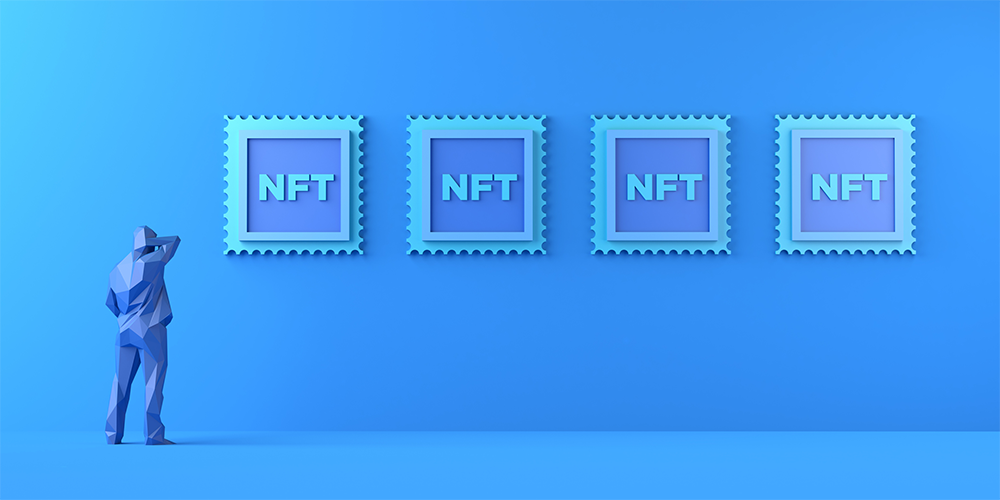In the late 14th century, the Italian Renaissance started as an artistic movement with deep scientific, political, economic and philosophical repercussions spanning through to the 17th century. In 2021, non-fungible tokens have spurred a digital renaissance which gave artists a new canvas to express themselves on. It remains to be seen if this movement can carry over to other industries, such as financial services.
In layman’s terms, a NFT is a single digital asset living on a blockchain. It is defined by attributes in the form of code and metadata. NFT use cases are not limited to digital or physical art, but can also cover identification, property rights and securitisation. Nevertheless, few NFT use cases involve bank loyalty programmes.
In the first quarter of 2022 NFT trading volumes were up 200% year-on-year, following a 21,000% increase in 2021. This suggests that NFT projects – such as CryptoPunks – are entering the mainstream. Furthermore, corporations such as Adidas and Visa are engaging with and supporting the NFT community. After irrational exuberance slowly left the market in the first half of 2022, banks should start exploring this new technology, build lasting use cases and engage clients more actively.
Banks have used points and miles systems to build customer loyalty, create brand awareness and facilitate customer segmentation. These products have empowered banks to maintain privileged relationships with their most profitable clients. NFTs go further by enabling their issuers and creators to build exclusive communities, which can complement credit card products.
Digital collectibles can add to existing loyalty programmes. They create deeper relationships between the customer and brand, as clients can own a rare digital asset closely tied to the bank. In addition, NFTs enhance personalisation initiatives as they can be designed to suit individual client preferences. For example, a digital art piece with post-Impressionist inspirations may be issued to an avid Vincent van Gogh collector while Burberry-branded in-game accessories may be offered to a client with a passion for clothing.
NFTs offer new ways to reward customers for their sound saving and borrowing practices. They also allow banks to create new, exciting digital experiences. Additional advantages of NFTs include traceability, managed transparency and security. Each digital asset is easily traceable because it is tied to an owner on-chain. Transparency fosters trust as blockchains offer a common ledger for all participants to verify transactions and ownership information. Nevertheless, total transparency may not always be desirable. Banks should therefore carefully consider their readiness for public versus permissioned blockchains. Finally, the underlying consensus mechanism and technology maturity are key determinants of blockchain security and should not be overlooked.
How should NFTs be used in loyalty programmes? First, teams should define the NFT strategy. This means clarifying the objectives, target audience and distribution of the NFTs. Do programmes want to reward existing customers by airdropping rare digital tokens? Do they aim to expand the customer base to Web 3 digital natives and diversify assets into cryptoassets? Will they offer these NFTs to a small user base as a token of appreciation or sell them to a wider audience? Will clients be able to sell their NFTs on a secondary marketplace or hold them in a digital vault?
Next, teams should determine the customer benefits of holding, instead of selling, the NFT. For example, will it give them access to airport lounges like certain credit cards?
Will ‘super rare’ NFTs allow their holders to attend exclusive wealth management conferences and offer businesses new opportunities to cross-sell new products? Will they open the doors to private virtual rooms and social media groups of crypto enthusiasts?
Loyalty programme teams next must work with a crypto-native team to convert the strategy into code. Operations must be planned thoroughly. Teams must be ready to assist customers on launch day. In parallel, legal and accounting teams should consult specialised digital assets advisers. Finally, the underlying blockchain and smart contract language need to be selected after a comprehensive strategy is in place.
Building a strong NFT community will increase customer loyalty and could improve the customer experience by introducing a new way to reach clients online. It is therefore critical to engage NFT holders constantly through professional and non-professional events. Some companies are also experimenting with gamification methods such as scavenger hunts and puzzles.
For instance, the VeeFriends collection, created by Gary Vaynerchuk, an American-Belarusian entrepreneur, is an example of how to provide lasting value with digital goods. A VeeFriend NFT includes a three-year pass to VeeCon, an exclusive conference, for its holder.
While digital arts may have become saturated, NFTs are ‘blue oceans’ for financial institutions. A small number of established institutions in the luxury industry have experimented in this emerging sector. Some have been successful and are renewing strategic collaborations with their communities.
Nevertheless, very few financial institutions have decided to move forward with NFT initiatives. Visa notably stands out with its CryptoPunk purchase and the launch of its NFT creator programme. This is akin to an accelerator programme for artists, musicians, fashion designers and film makers who leverage NFTs in their businesses. It is also a testament to their support of the NFT industry. In this respect, it is reminiscent of how the house of Medici commissioned art pieces in Florence at the start of the Renaissance.
Will banks and other financial institutions step up and deploy capital to spur this new digital renaissance? We will see. Tier one financial institutions – such as Standard Chartered, HSBC, DBS and JP Morgan – have already set up shop in the metaverse. They all purchased land in the Sandbox, a leading decentralised game, to experiment with Web 3 and create new experiences for their customers. Offering NFTs to their clients could boost their asset management and custody business with retail customers, while still offering them the option to have complete ownership of the digital collectible in a non-custodial wallet.
Olivier Truquet is Asia Pacific Distributed Ledger Technology Lead at GFT.
